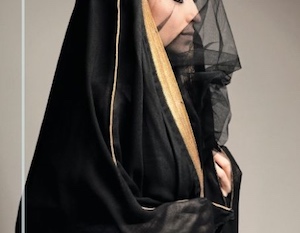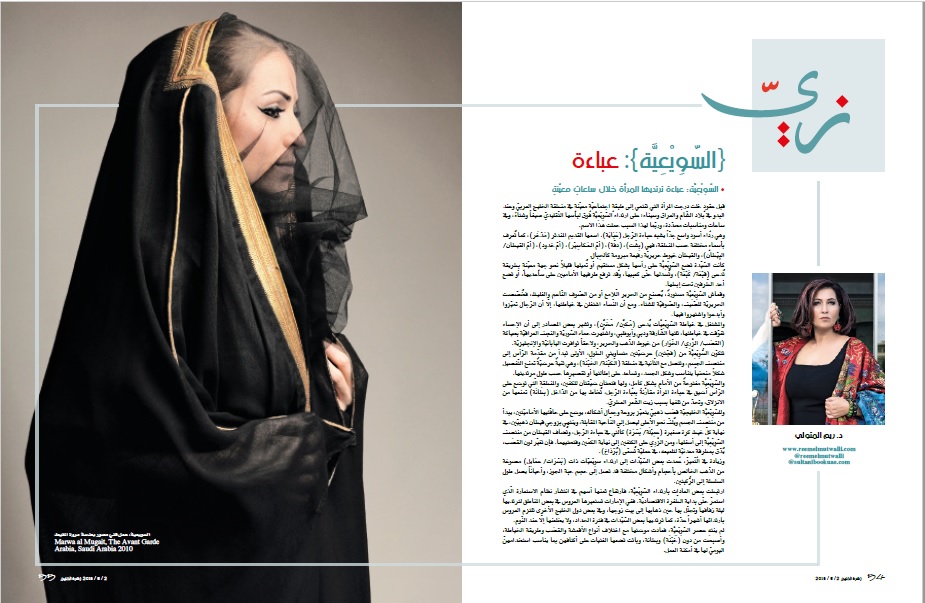




السُّوَيْعَة: تصغير ساعة، وهي جزءٌ من الّليل والنّهار، والجمع: ساعاتٌ وساعٌ
السّوِيْعِيَّة: عباءة ترتديها المرأة خلال ساعاتٍ معيّنةٍ
قبل عقودٍ خلت درجت المرأة الّتي تنتمي إلى طبقةٍ اجتماعيّةٍ معيّنةٍ في منطقة الخليج العربيّ وعند البدو في بلاد الشّام والعراق وسيناء؛ على ارتداء السّوِيْعِيَّة الباهظة الثمن فوق لباسها التّقليديّ صيفاً وشتاءً، وفي ساعاتٍ ومناسبات محدّدة، وربّما لهذا السبب حملت هذا الاسم
وهي رداء أسود واسع جدّاً يشبه عباءة الرّجل (عَبَايَة). اسمها القديم المندثر (مَدْخَر)، كما تُعرف بأسماءٍ مختلفة حسب المنطقة، فهي (بِشْت)، (دفّة)، (أمّ الـمَـﭼَاسِيْر)، (أمّ خدود)، (أمّ الگِيطان/ البِيْطان)، والگِيطان/ الْقِيْطان
كانت السّيّدة تضع السّوِيْعِيَّة على رأسها بشكلٍ مستقيم أو تُميلها قليلاً نحو جهةٍ معيّنةٍ بطريقة تُدعى (گَبْعَة/ ﭼَبْعَة)، وتُسدلها حتّى كعبيها، وقد ترفع طرفيها الأماميين على ساعديها، أو تضع أحد الطّرفين تحت إبطها
وقماش السّوِيْعِيَّة مستوردٌ، يُصنع من الحرير الّلامع أو من الصّوف النّاعم والغليظ، فخُصّصت الحريريّة للصّيف، والصّوفيّة للشّتاء. ومع أن النّساء اشتغلن في خياطتها، إلّا أن الرّجال تميّزوا وأبدعوا واشتهروا فيها
والمشتغل في خياطة السّوِيْعِيَّات يُدعى (مْـﭼَبِّن/ مْخَبِّن)، وتشير بعض المصادر إلى أن الإحساء تفوّقت في خياطتها، واشتُهرت حماه السّوريّة والنجف العراقيّة بحياكة (الگَصَب/ الزَّرِي/ الخْوَار) من
تتكوّن السُّوِيْعِيَّة من (فجّتين) عرضيّتين متساويتا الطّول، الأولى تبدأ من مقدّمة الرّأس إلى منتصف الجسم، وتتصّل مع الثّانية في منطقة (الْـﭼَبْنَة/ الخَبْنَة)، وهي ثنيةٌ عرضيّةٌ تمنح التّفصيل شكلاً منحنياً يتناسب وشكل الجسد، وتساعد على إطالتها أو تقصيرها حسب طول مرتديتها
والسّوِيْعِيَّة مفتوحةٌ من الأمام بشكلٍ كاملٍ، ولها فتحتان ضيّقتان للكفّين، والمنطقة الّتي توضع على الرّأس أضيق في عباءة المرأة مقارنةً بعباءة الرّجل، تُخاط بها من الدّاخل (بْطَانَة) تمنعها من الانزلاق، وتحدّ من تلفها بسبب زيت الشّعر العطريّ
وللسّوِيْعِيَّة گَصَب ذهبيّ يتميّز بروعة وجمال أشكاله، يوضع على حافّتيها الأماميّتين، يبدأ من منتصف الجسم ويُلفّ نحو الأعلى ليصل إلى النّاحية المقابلة، وينتهي بزوج گِيطان ذهبيّة، في نهاية كلّ
وزيادة في التّميزّ؛ عمدت بعض السّيّدات على ارتداء سّوِيْعيّات ذات (بَسْرَات/ عْمَايِل) مُصاغة من الذّهب الخالص بأحجام وأشكال مختلفة قد تصل إلى حجم حبة الجوز، وأحياناً يصل طول السلسلة إلى الرُّكبتين
ارتبطت بعض العادات بارتداء السّوِيْعِيَّة، فارتفاع ثمنها ساهم في انتشار نظام الاستعارة الّذي استمرّ حتّى بداية الطّفرة الاقتصاديّة. ففي الإمارات تستعيرها العروس لترتديها ليلة زفافها وتجلّل بها حين ذهابها إلى
بَيْت: (بالفصحى، الجمع بُيُوْت). تُستخدم المفردة في الإمارات للدلالة على الجزء الأوسط الأكبر من كفة السروال (بادلة) المزينة بالتلي، ويمكن أن يتضمن البيت 21 ضفيرة (تلي_فاتلة)، تُخاط يدوياً جنباً إلى جنب بأشكال مختلفة، وتُحاط ببعض الخطوط المكونة للحافة (
طْرَاف: (بالعامية. بالفصحى: أطْرَاف، المفرد: طَرَف، أي الحواف أو الحدود). تشير هذه المفردة الإماراتية إلى حافة أو حد البيت في بَادْلَة السِّرْوَال، أي كفّته.

Al-
Suwai’yiah
Whilst the literal translation
of the term refers to ‘certain hours’ or ‘brief hours’, generally between
sunset and sunrise, it is applied to the formal and more expensive outer-cloak
which women from a higher social class in the Arabian Gulf and Bedouin in the
Levant, Iraq and Sini wore for special occasions. It is an expensive article of
dress reserved to a higher social class of women in the Arabian Gulf and
Bedouin women in the Levant, Iraq, and Sinai. Since it was not worn all the
time, this is how the garment probably gained its name.
It is a broad black robe, that
resembles a man's cloak abaya known by different names depending on the
region: Medkhar, Bisht, Um al Michasir, Um Khdud, Um Gitan/Bitan. The
latter term denotes to the fine golden silk coil which decorates the hemline.
Women would place the Suwai’yiah
on their heads, either straight up, or slightly tilted to one side, and drape
it down their back. At times they gather the two open front portions folding it
up with their arms to their waistline or choose to tuck one end under their
armpit.
The fabrics which were used to make the Suwai’yiah were imported. Sources indicate that the best were produced in Al-Hasa / ‘HSA’ in Saudi Arabia. While Hama and Najaf, in Syria and Iraq respectively, are most famous for weaving the gilded adornments using gold and silk threads. Today many are manufactured in Japan and in the UK. The fabrics included lustred satin silk worn during the summer period, whilst the soft and thick wool was reserved for the Winter. Although women have been known to sew this garment, it is the men who gained fame for their distinguished and creative tailoring skills.
The Suwai’yiah consists of two joint rectangular widths of fabric, the first covering the upper part of the body, extending from headline/shoulder line to midriff, leaving the second to cover the remaining lower part of the body. The joint line known as Khat al Khabun creates the line where the article can be lengthened or shortened. The two widths once joined are laid flat; the outer edges on both sides are then folded to the centre creating the front opening and forming the general shape of the article. The top hemline is closed to create the shoulder line and the hand slits are then opened at the sides.
The Suwai’yiah
is fully open at the front, and the area on the head is narrower on woman's
garments compared to those worn by men. At times, it is lined with a small
piece of fabric that prevents it from slipping off and protects it from being
damaged by the aromatic oils used on the hair.
The garment is decorated with beautiful, intricately woven patterns of gilded silver coil, hand or machine embroidered zari on its frontal opening, starting from the middle of the body and running all the way up around the head crown then down the opposite side. On the endings of this line on each side hangs a pair of small golden orbs ‘Amayl, like those decorating the male version of the garment. Gold zari also embellishes the shoulder line all the way down to the edges of the sleeve, and around them. If the colour of the thread used to decorate the garment change, the lustre is renewed by tapping it with a metal hammer.
To make it even more distinguished, some women wear the Suwai’yiah with a finial of pure gold, in various shapes and sizes, some are the size of a walnut, with the chains hanging all the way down to the level of their knees.
There were several traditions
connected to wearing the Suwai’yiah, as they were so dear, up
until the economic boom, it was common for people to borrow this garment for
special occasions. In the United Arab Emirates, the bride borrows a cloak to
wear on her wedding night, for when she is escorted to her groom’s home. In
other Gulf countries, the bride is required to wear it for a couple of months
after, while others wear it during their mourning period, and only take it off
when they go to sleep.
Wearing the Suwai’yiah
has not gone out of fashion, it has only changed and developed in style,
reappearing on women in new types of fabrics, techniques and occasions.